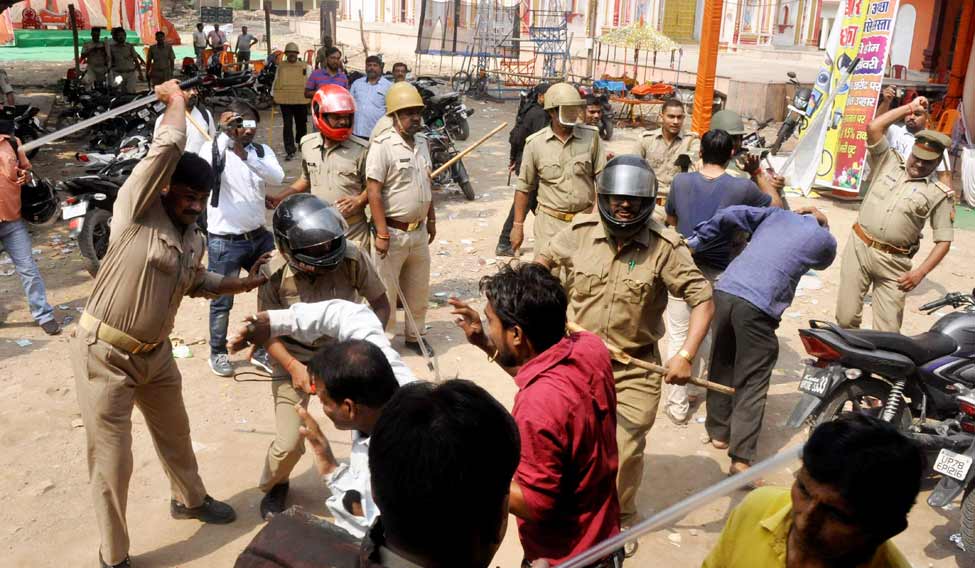India’s pluralistic fabric was once again stretched to its limits as communal violence flared during Muharram processions across three major states—Bihar, Madhya Pradesh, and Uttar Pradesh. The disturbing common thread: targeted attacks, allegedly by Muslim mobs, on Hindu temples and residential areas predominantly occupied by Hindus.
This unsettling pattern has sadly become a recurring feature during certain religious occasions in areas with a mixed population. The question we must now ask, without fear or favour, is: who is stoking this violence—and why?
These incidents have not occurred in a vacuum. Every time clashes erupt, the blame game follows a familiar path. Representatives of the Muslim community, especially religious and political figures, often rush to blame the law enforcement agencies and the state governments, particularly when the BJP is in power. While it is fair to hold any ruling government accountable for law and order, this deflection of responsibility ignores a deeper malaise. The communal flare-ups are rarely spontaneous; they seem orchestrated, designed to provoke, and far too consistent in their targeting to be dismissed as accidents.
In Bihar’s Muzaffarpur, Madhya Pradesh’s Khandwa, and Uttar Pradesh’s Bareilly, Muharram processions saw sudden flare-ups when they approached Hindu localities or temples. In several cases, stone pelting was reported. Temples were vandalized. Videos surfaced showing aggressive sloganeering and mobs brandishing weapons in what should be a solemn and spiritual event commemorating sacrifice and mourning. What happened to the celebrated Ganga-Jamuni Tehzeeb—India’s unique blend of syncretic culture that once defined communal harmony?

The onus of restoring that harmony does not lie on state governments alone. It lies equally—if not more—on religious leaders and community influencers. It is their moral responsibility to ensure that religious events are not hijacked by lumpen elements. Yet, in most of these cases, clerics remain conspicuously silent or worse, offer justifications rooted in victimhood narratives. This silence, or selective outrage, undermines India’s secular commitment.
To be clear, the governments in BJP-ruled states cannot escape blame. Given the history of such flare-ups, especially during Muslim festivals in communally sensitive areas, they should be far more vigilant. It is imperative that they deploy security forces pre-emptively around Hindu temples and residential colonies that have been targeted before. Public messaging should be unambiguous: any attempt to provoke violence—whether by processionists or residents—will be met with an iron hand. Shoot-at-sight orders might sound extreme, but if they serve as a deterrent to mob violence, their consideration is not out of place. Better still, preventive policing and intelligence coordination should neutralize such threats before they flare up.

A critical contrast must be highlighted. Such targeted aggression is rarely seen in Congress-ruled or regional party-ruled states like West Bengal, Kerala, or Tamil Nadu. Is it because communal harmony thrives there—or is it because Hindu voices are systematically suppressed in the name of “secularism”? In these states, Hindu festivals like Ram Navami, Hanuman Jayanti or even Diwali face curbs—procession routes are altered, permissions denied, and celebrations policed as potential threats. Meanwhile, minority events are facilitated without similar scrutiny. This is not secularism—it is selective secularism, engineered to appease one community at the cost of another.
The time may have come for a larger national rethink. If religious gatherings are becoming potential flashpoints, then all places of worship—especially vulnerable temples in mixed-population zones—should be brought under the protection of Central or paramilitary forces during sensitive periods. If this seems excessive, one only has to ask: what is the alternative? Year after year, we are witnessing a repetition of the same tragedy.
India’s Constitution guarantees equal rights to all religions, not special privileges to one, nor special restrictions on another. Yet in practice, Hindu festivals like Diwali and Holi are increasingly vilified under the guise of environmental concerns. Crackers pollute, say the courts. Colours waste water. But where is this concern when thousands of animals are sacrificed publicly during Eid al-Bakrid? Why the double standards? If we respect one faith’s symbolism and traditions, the same courtesy must be extended to others, especially the majority that forms the core of this nation’s civilization.
India’s secularism cannot be one-sided. Nor can it be a shield to cover up recurring communal aggression. The onus is now on Muslim religious leaders and intelligentsia to introspect, act responsibly, and ensure that their festivals remain peaceful and pious, not militarized street shows that threaten harmony.
Appeasement politics has done enough damage. It is time to protect every Indian—Hindu, Muslim, Sikh, Christian—not by hiding facts but by confronting uncomfortable truths. Real pluralism is not about suppressing grievances; it is about equal accountability and mutual respect.





